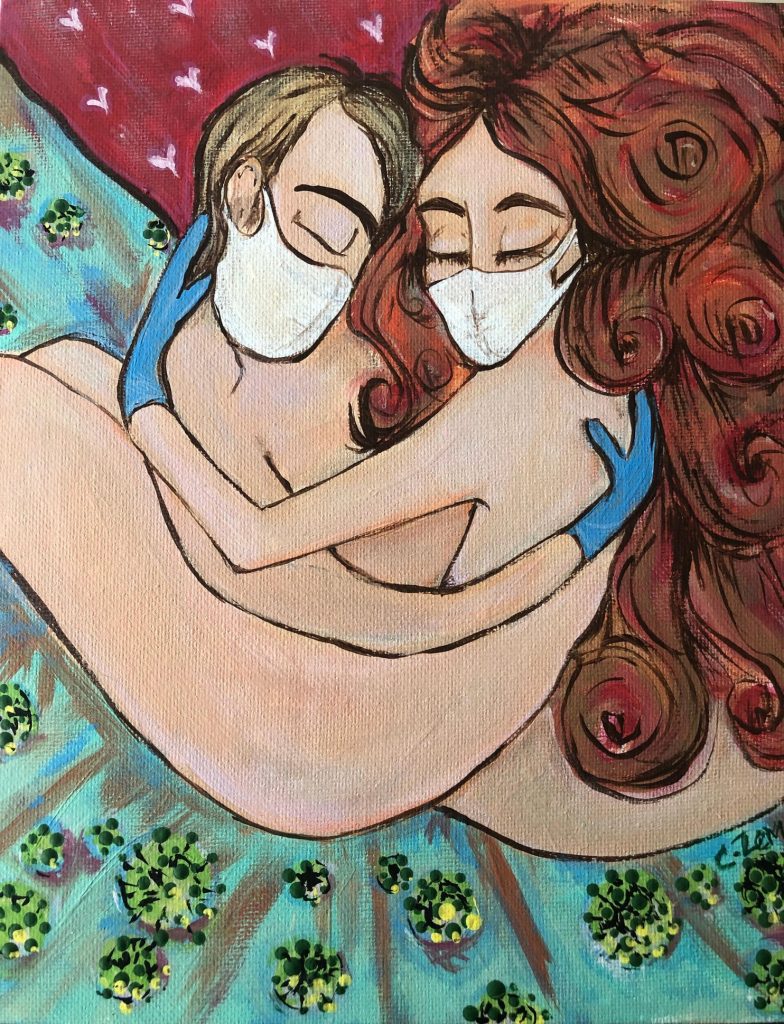
I was impressed by this painting while reading an article in the Washington Post about art created during the pandemic. The artist was “Considering life with covid-19 and the future of intimacy”, but I started to consider the myriad of ways that the corona virus has already impacted artists and our culture.
But before we begin to assess the devastating impact that the pandemic has had on the arts and culture, let’s not forget that artists of all kinds have already been reeling from a decades long digital assault. Once their creations became readily accessible and freely transmitted over the internet, their value diminished substantially, erasing traditional revenue sources. In response, artists turned their focus to physical objects and live experiences in their effort to replace the lost income. Musicians sought performance opportunities in new settings and toured more often. Writers and illustrators held more lectures, classes, and workshops. New festivals and art fairs of all kinds were springing up and thriving. However, the pandemic has ended all of those activities, including television, film production, commissions, residencies, as well as income sourced through teaching and even waiting on tables.
The economic impact of the pandemic on the arts has been swift, and Congress acted with an appropriation of $75 million to the National Endowment for the Arts through the CARES Act. Even so, there has been $13.9 billion in lost revenue to date. The average loss to each arts organization has been $28,500, while the MET Opera has lost over $60 million. So far, 96% of them have had to cancel events, suffering a loss in attendance of over 105 million people, which has forced them lay off 62,00 in staff, furlough 50,000 more, and severely impacting donors generosity. What disturbs me most – as long as the public’s safety remains at risk and the need to practice social distancing persists, no-one can predict nor envision the return to any kind of normal cultural environment.
Artists and cultural organizations have already begun ‘adapting’ to these circumstances, responding with new business models and changing the way they will conduct their businesses over the next year. Their focus has turned to their digital presence, using social media and emails to connect with their communities and promote online concerts, exhibits, workshops and coaching sessions. The Chicago Symphony has launched a new video portal to stream their entire 2020 season and will broadcast a new series of archival performances on radio. The Cleaveland Orchestra has similar plans for their season as have the NY Philharmonic, which has even added outdoor ‘pull up concerts’ as weather permits. Museums have made millions of works of art available digitally and created virtual tours of their collections. Individually, artists are using skills acquired in dealing with the internet to offer online workshops, classes, lessons, and masterclasses on Zoom, Facebook Live, and Google Hangouts.
But while all of these activities might provide much needed revenue to help the arts survive, all of the ‘free content’ that’s being generated will ultimately benefit the tech giants far more. The transfer of wealth from the artist who creates to the Silicon Valley tech distributors is enormous, in the tens of billions of dollars annually. Those who count the clicks and sell the advertising and meta-data collected are being enriched with unparalleled power and money. As our existence and our attention now pivots even more to screens, one can only wonder if audience attendance will ever return to pre-pandemic levels.
In a way, the pandemic may be a catalyst for artists. Not only in making a living, but in understanding their own experience, and then, in how to share that with others. The isolation and downtime has been used by many artists – myself included – to pursue projects that required time and attention previously unavailable. It’s also allowed for the kind of personal inner space for one to reflect and rethink, revisit and re-evaluate, refresh and re-imagine.
No one should be surprised by the creativity and innovation artists are now employing to continue their craft, build their communities, and support themselves. The role of art has become more important, and the environment in which art is created has changed. But I have no doubt that it will go on, reminded by the words of Leonard Bernstein.
“It is the artists of the world, the feelers and the thinkers who will ultimately save us; who can articulate, educate, defy, insist, sing and shout the big dreams.”